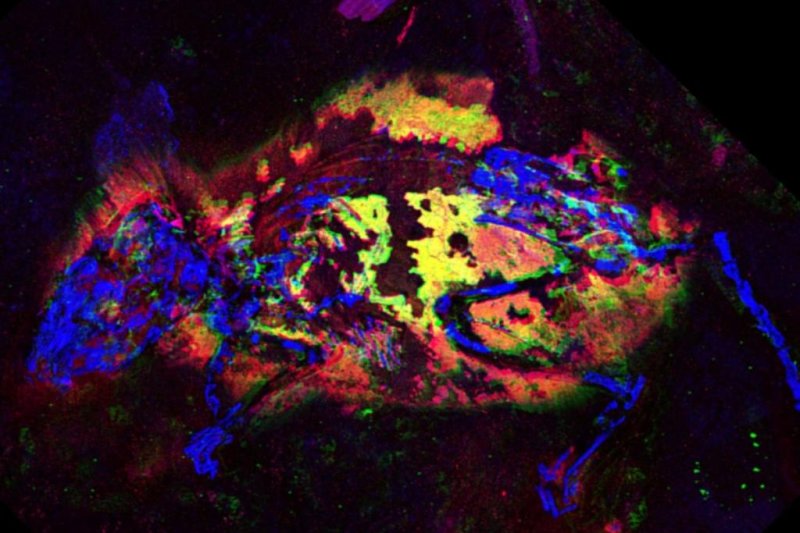To identify the chemical signatures of ancient pigments, scientists bathed a 3 million-year-old mouse fossil in X-rays. Photo by Phil Manning/Manchester University
May 23 (UPI) -- Redheads are at least 3 million years old. Scientists have discovered red pigment inside the fossilized fur of an ancient mouse specimen found in Germany.
The discovery, detailed this week in Nature Communications, suggests mice a few million years ago looked a lot like they do today.
"Here we find that a 3 million-year-old mouse looks just like a modern mouse," Uwe Bergmann, research scientist at the U.S. Department of Energy's SLAC National Accelerator Laboratory, told UPI. "While this might not be a big surprise, it is -- the fact that we can identify such pigments, now, will have an impact on future findings."
Bergmann and his colleagues at SLAC worked with scientists at Stanford University to identify the chemical signatures of red pigment inside the ancient mouse cells.
To confirm the presence of ancient pigment, scientists first needed to study how modern -- and less-degraded -- pigments interact with other elements. To study these chemical interactions, scientists bathed old and new cells in X-rays using the Stanford Synchrotron Radiation Lightsource.
"With our technique, we take advantage of the fact the melanins associate with metals," SLAC scientist Nick Edwards said. "Other organic pigments such as carotenoids, which produce, for example, the bright colors in parrots, do not easily associate with metals and are currently not detectable with our technique."
Researchers found the same signatures of chemical bonds between red pigment and trace metals in the old and new cells.
The cornucopia of color visible throughout the animal world is proof of the evolutionary importance of pigmentation, but until recently, scientists could say little about the colors of the ancient world.
"Color and pigmentation is critical for survival of a species and for evolution as camouflage, sexual selection, UV protection, heat regulation and keeping the body in equilibrium," Bergmann said. "There is also some speculation that the presence of metals, such as copper for example, potentially prevents decay of soft tissues from bacterial attacks."
By coloring the ancient world, scientists can better understand how animals interacted with one another and with the natural world. An ancient ecosystem with color is one scientists can more easily decipher.
"For most fossils we have no idea about the color of the living animal. For example all color depictions of dinosaurs are purely imaginative," Edwards said. "We want to know how ancient live forms looked like, also for comparison to modern life form. Knowing this helps with understanding evolution."
Bergmann and Edwards continue to look for new ways to paint a fuller picture of ancient life.
"We are currently working on a series of fossil studies to show how the fossilization processes occur, and what influence the animal fossilization process has on its local environment and vice versa," Bergmann said. "This is basically a type of chemical forensics of dramatic events that happened millions of years ago, and we find that very exciting."















